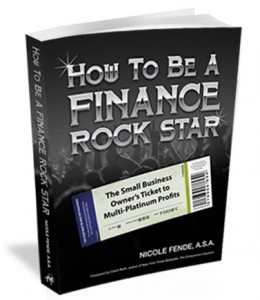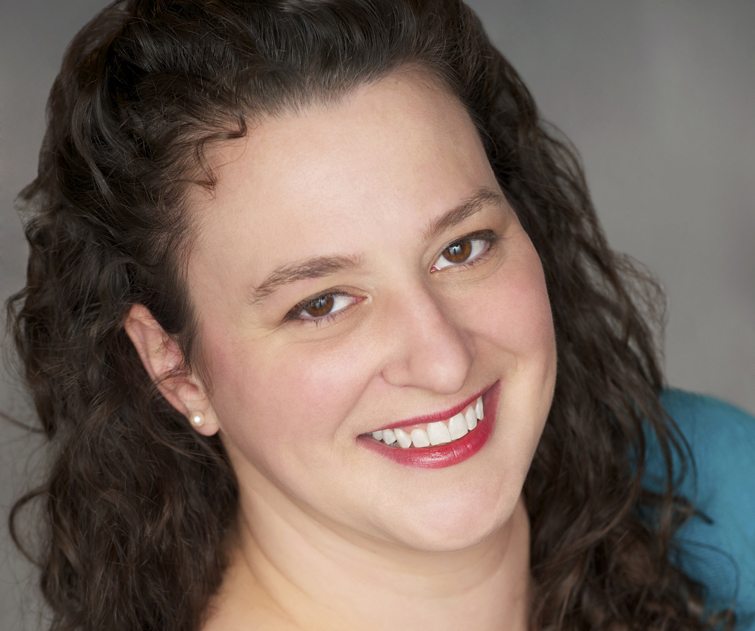As the President of Small Business Finance Forum, Nicole Fende, aka the Numbers Whisperer™ is a credentialed actuary with experience as a Chief Financial Officer, Investment Banker, and successful entrepreneur. She’s also the author of the new book, “How to be a Finance Rockstar.”
In her book, Nicole shares the same strategies she uses for her profit coaching clients to help them reach multi-platinum profits. It’s an easy, practical go-to reference guide for mastering small business finance. The bonus? There’s even a section on marketing where you’ll learn the principles of pricing your products and services, as well as how to run a cost-effective promotion.
Despite Ms. Fende’s endless list of impressive credentials, her true claim to fame is her ability to make finance fun. From her LOL blog posts, such as College Keggers Teach Complex Expense Analysis, to the endearing finance mascot Fluffy, she entertains entrepreneurs while helping them grow their bottom line. (This definitely isn’t the finance you slept through in college.) Last week I talked with Nicole about the marketing she put together for the book launch. The entire interview is on BlogTalkRadio.
TS: What was the impetus for you to put this book together?
NF: I was watching the Right Brain Business Plan Summit last year and realized that as a coach, I often get many of the same kinds of questions from my clients. I knew that a book would help answer some of those.
TS: How did you plan out putting the book together?
NF: It was really starting from those common questions I was getting. I began writing blog posts that addressed them. Once I had most of the content, I began working on a theme — something that’s really important if you want to pull all that content together. And then everything needs to relate back to that theme — which isn’t always easy. The theme I picked was the Rockstar. I felt that was the complete opposite of how people felt about themselves in relation to their finances. You don’t think of rockstars as sitting there with calculators and spreadsheets.
TS: That’s a really good point. So many times people don’t pause to think about what exists in total juxtaposition to the thing that they do. When you use a metaphor that’s the total opposite of what people expect, that’s when they pay attention. It works really well. So yes, total left brain, straightlaced finance professional in a rockstar world. That’s one of the reasons I loved your marketing. When did you really start formalizing the marketing plan for the book launch?
NF: It was in the back of my mind for awhile. What I did was read a lot about how other people promoted things. I tried to be a sponge. I knew that I’m a finance person, not a marketing person — so I would have to step outside my comfort zone a little. And what I started to see were commonalities. Part of what numbers people like to do is categorize. Categorize and analyze. It’s actually a really good skill.
So I started breaking down my reading and I saw that whether people were promoting a new book, a new product or a store opening, there were commonalities — or lessons. And those were the things I needed to cover for this, or for anything else I might want to promote.
One of those was: Create interest ahead of time. Just like movies. The day a movie comes out is not the first day you hear about it. 
Another was Build a broad network. I had a pretty good network already, but I knew I needed to broaden it. I wanted to make sure that I met new people from a lot of different areas. So I made a conscious effort to participate in new Twitter chats and to visit blogs from a variety of topics. To basically not live in a bubble. It’s very easy to find a clique and get comfortable there. Both online and offline. Unless you’re best friends with Oprah, you can’t really just have one friend promote you and be done. You need to look around and find folks who may have a similar target market. You can even collaborate with those who some might think of as competition.
I’m going to refer back to Jennifer Lee’s book (The Right Brain Business Plan). She refers to competitors as “collaborative cohorts.” Her whole idea is that there’s such a huge market that there’s room for everyone. So for instance, if I wanted to sell a book just to solopreneurs in the United States, the last business association numbers on that target market is 20 million people. Now I would love to sell 20 million books. I really would. But the odds of that happening are slim to none. Even if I got on Oprah. Part of the reason for that is that your target market is not everybody. Y
ou talk about that, Tea. Not everyone is going to relate to my humor, for example. But if I coordinate with somebody else who has a similar target market, some of them are bound to relate to my sense of humor. We can work together and band together, and we’re stronger for it.
TS: That’s exactly right. As solopreneurs we have to work with others in order to be successful.
NF: If you don’t reach out, you’re limiting your profit. Which ties into another thing I realized. If you look at any book that’s been successful — especially if it’s the first book the author puts out — there’s a forward written by an established author or business professional. I realized that having that would be important to give me additional credibility.
I had the good fortune of being connected with Carol Roth who wrote the Entrepreneur’s Equation. She’s someone you might think of as being a competitor of mine. We have a similar background, but she’s got a very different tone and approach. I love it, it’s just not mine. And so I viewed her as someone I could look up to and learn from and be a colleague with, versus a competitor.
I knew that I wanted to meet her, so I reached out to some people in my network and said, “If you know Carol Roth, I’d love an introduction.” And lo and behold, I found six people in my network who knew her. It was around the time that her book was really going hot and heavy so she was too busy to connect with me at that point.
But then, out of the blue, Margie Claymen, emailed me and said, “You two should do a video together exploring issues about women in finance” (that’s a topic near to her heart). So I followed up, and we hit it off and from there — I asked her to help me with the forward.
And what I think is important to remember before you ask someone for any kind of favor, is that you’ll need to help them understand how helping you will benefit them. How it fits with their target market. And that you’re putting together a quality product (because they don’t want to put their name on something that is less than excellent). I told Carol I had hired an illustrator, a graphic designer and a copy editor and that I had a solid marketing plan for the book. I also talked with her about how the book ties in perfectly with what she does. Carol looks at the overall strategy behind being an entrepreneur. My book fills in the money gap.
TS: How long did you wait (after working with her) before you asked Carol to write your forward?
NF: A few months. I got to know her in other ways first. I think you need to be careful that you don’t ask somebody immediately for something when you first meet them. You need to demonstrate that it’s a two-sided relationship. When I did the video interview with Carol, I made a point of promoting her book. Which is a fabulous book. I wasn’t just doing it to be kiss-as$. She wrote an excellent book for someone thinking about becoming an entrepreneur. And people should read it.
TS: That’s so important. The relationship needs to come first, for sure. How long of a lead time did you give yourself before you started the promotion?
NF: Not long enough. And that was a huge lesson for me. Write down how long you think you’re going to need and then multiply that by 2 or 3. I worked with a marketing professional to come up with the road map, and I could’ve easily taken another 6 months to do the work. My recommendation is to set a deadline and then work backwards from there. It’s just way too easy to keep putting things off.
TS: I always tell people to reverse engineer their projects. When you do, you’ll find out if you don’t have enough time. And you can make the decision at that point to go forward or not.
NF: I found that I needed to give more time to many of the things I did. For example, one of my promotions was a Fluffy Sighting. Fluffy is my mascot — Fluffy the Finance Feline. He’s in my book and I thought it would be fun to have him loose on the internet — kind of like Elvis Sightings. The idea was to have different blogs host him for a day and have people go and find him. There was a contest and the whole nine yards. I should’ve anticipated that some of the busier blogs would need more time. At least a month or two warning in order to get on their calendar. And I didn’t do that. I heard from some of them that they would’ve loved to participate but their editorial calendars were already in place. And unfortunately, I couldn’t move things around for them because by that time, I was already committed to the rest of the marketing schedule. So if you want to involve other people and blogs — and I strongly recommend that you do, if you want to create that buzz — that you start reaching out to people at least two months before your launch date. That’s a minimum. Big lesson learned!
TS: That’s something folks need to remember too about guest posting in general. Other blogs have editorial calendars. And just because you’re having a launch, doesn’t mean you’re going to be able to time those posts with the rest of your promotion. You can ask, of course. But more often than not, you just have to allow the blogs to publish you when they want to publish.
NF: The other thing you need to do is make it compelling for them. Obviously, I have a vested interest in my own launch and getting them to do things with me. So I had to sit down and think about this a little more. Remember the WIIFM rule (What’s in it for me?). Yes, the Fluffy Sighting contest was fun, and a lot of people said, “Sure!” Just based on the fun factor. But, if you’re approaching blogs that are bigger than yours, you need to give them good reasons as to why they may want to participate. Especially if you want them to commit to a date. I said, “This is a contest and I will be driving quality traffic to you.” I told them who my target market was (obviously, these matched my target market). I told them that I believed it fit with theirs.
TS: One of the things that impressed me was how well organized your marketing promotions were. How did you feel about it all?
NF: We always want to do better, but I’m very proud. The exposure and buzz that I got was exactly what I was going for. I also had a launch party that I streamed lived. We had a cocktail party with giveaways…all of that, for someone who’s not a marketing person, makes me feel really proud of how well it all came together. It just goes to show you that you don’t have to be a marketing expert yourself — you just have to listen to the marketing experts and stay organized.
Nicole’s book is available on Amazon. Go get it! And if you have any additional questions about Nicole’s book launch marketing campaign, leave them here and I’ll see if I can get her to share more.










